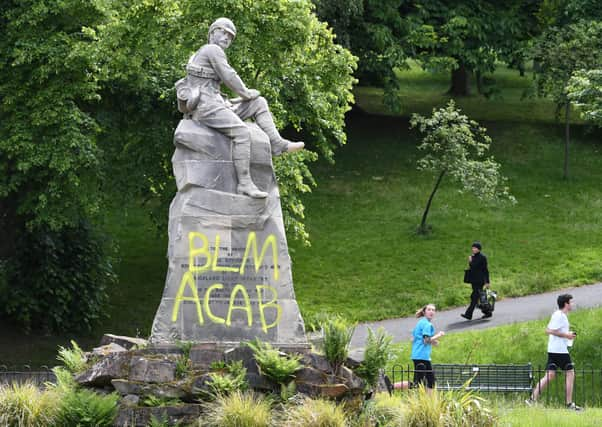Priti Patel warns BLM protesters will face justice for vandalism


A plaque will be added to one of Edinburgh’s most prominent landmarks highlighting the role of Henry Dundas in the slave trade, as the Home Secretary warned race equality protesters they will face justice for acts of vandalism and violence.
Edinburgh City Council leader Adam McVey confirmed talks will be held between the council, Edinburgh World Heritage and Heriot-Watt University emeritus Professor Geoff Palmer – the first black professor in Scotland – to determine “as quickly as possible” how the plaque will be worded.
Advertisement
Hide AdAdvertisement
Hide AdActivists in Scotland had renewed calls for recognition of Dundas’ role in obstructing the abolition of slavery in the 18th century, encouraged by Black Lives Matter demonstrations across the United States and around the world.


The killing of an unarmed black man, George Floyd, by police in the US city of Minneapolis sparked a wave of protest around the globe.
Demonstrations across the UK on Sunday saw protesters in Bristol pull down a statue of Edward Colston, a 17th century slave trader responsible for shipping tens of thousands of Africans into slavery, thousands of whom are thought to have died. Hundreds of people cheered as the toppled statue was rolled through the city and dumped in Bristol harbour, where Colston’s human cargo was disembarked.
There were also violent scenes at protests in London, with 35 police officers and one protester injured in Sunday’s clashes on Whitehall. Two officers were being treated in hospital yesterday. Police made 135 arrests.
Home Secretary Priti Patel said isolated incidents of violence and vandalism were “shameful”, warning those responsible: “You will face justice.”
In London, the Cenotaph war memorial was graffitied and the statue of Winston Churchill in Parliament Square had the word “racist” spray painted on it.
And in Glasgow, a Boer War memorial and a statue of Thomas Carlyle in Kelvingrove Park were also vandalised, as was a statue of Robert Peel in George Square.
Updating MPs on the demonstrations, the Home Secretary said: “As the ugly tally of officer assaults show, some protesters regrettably turned to violence and abusive behaviour at the weekend. This hooliganism is utterly indefensible. There is no justification for it.
Advertisement
Hide AdAdvertisement
Hide Ad“There is no excuse for pelting flares at brave officers, throwing bikes at police horses, attempting to disrespect the Cenotaph or vandalising the statue of Winston Churchill, one of the greatest protectors of our freedoms who has ever lived.
“It’s not for mobs to tear down statues and cause criminal damage in our streets, and it is not acceptable for thugs to racially abuse black police officers for doing their jobs.”
Ms Patel added: “To the criminal minority who have subverted this cause with their thuggery, I simply say this - your behaviour is shameful and you will face justice.”
Her message was backed by Labour leader Sir Keir Starmer, who said that while the Colston statue should have been taken down “a long, long time ago”, its destruction was “completely wrong”.
“It shouldn’t have been done in that way – completely wrong to pull a statue down like that,” Mr Starmer told LBC Radio.
“That statue should have been brought down properly with consent and put in a museum.”
But in a sign of how deeply the Black Lives Matter campaign’s anti-racist message is being felt, and how far the political debate has come, the Chancellor Rishi Sunak issued his own personal statement promising that while change is slow, it would be “permanent”.
“I know people are angry and frustrated,” Mr Sunak said. “They want to see, and feel, change. But a better society doesn’t happen overnight - like all great acts of creation, it happens slowly and depends on the cooperation of each of us toward that common goal.”
Advertisement
Hide AdAdvertisement
Hide AdIn Edinburgh, activists and councillors have been debating how to address the controversy surrounding the monument to the 1st Viscount Melville for over two years.
A plaque was originally planned to be installed by no later than September 2018, but councillors were unable to agree on wording.
At Sunday’s Black Lives Matter rally in Edinburgh, Prof Palmer renewed his call for a plaque.
“If you go up to St Andrew Square one day and you look at the statue of Henry Dundas, it’s 150 feet tall,” he told thousands of people gathered in Holyrood Park.
“Why is he there? He is there because he said the slave trade should be gradually abolished, not immediately abolished. We have a statue in the middle of the city to commemorate that man’s doing.”
Benjamin Carey, a descendant of Henry Dundas has backed calls for a plaque, telling the Scotsman that the monument in St Andrew’s Square should reflect his ancestor’s advocacy of slavery.
As first lord of the admiralty, Dundas fought to prolong slavery and protect the financial interests of the elite – forcing around 630,000 slaves to wait more than a decade for their freedom.
Speaking before yesterday’s announcement by Edinburgh Council, Mr Carey said he was “astonished” at the lack of progress in resolving the controversy surrounding the monument, particularly given the Black Lives Matter campaign “There is now an opportunity for the council to admit the role of one of its most influential figures by supporting the plaque committee to complete its work as quickly as possible,” he said. “My ancestor is controversial, but Edinburgh needs to own him, warts and all.”
Advertisement
Hide AdAdvertisement
Hide AdOn Sunday night Mr McVey responded to Prof Palmer’s speech, tweeting: “Thanks for your work on this. I’ll be speaking with colleagues tomorrow about where things stand and try to get things resolved.”
Yesterday the Edinburgh Council leader told the Scotsman: “When we scratch beneath the surface of our city’s long history – the sweeping streets of the New Town, some of the statues in our squares – we must face an uncomfortable truth. Edinburgh was, in part, built on wealth created by the slave trade. For too long this part of our city’s history has been hidden but we are starting to confront our past and need to go further.
“The statue of Henry Dundas in St Andrew Square at the very least requires a more representative story to be told... While a consensus wasn’t achieved with a previous approach, we need a resolution now to make a change and I have called a meeting of Edinburgh World Heritage, Prof Geoffrey Palmer and an expert from the University of Edinburgh with a view to agreeing a new form of words as quickly as possible.”